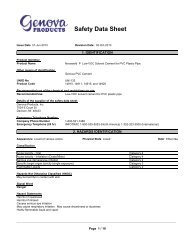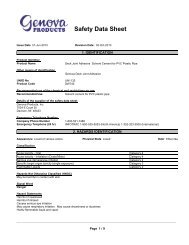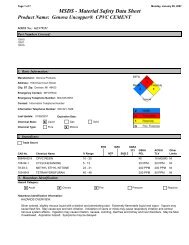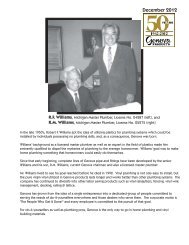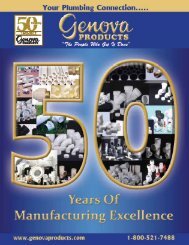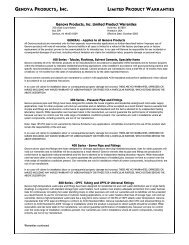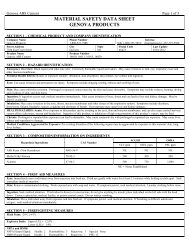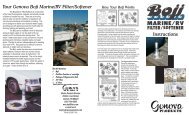NovaClean Cleaner/Primer - Genova Products
NovaClean Cleaner/Primer - Genova Products
NovaClean Cleaner/Primer - Genova Products
You also want an ePaper? Increase the reach of your titles
YUMPU automatically turns print PDFs into web optimized ePapers that Google loves.
<strong>Genova</strong> <strong>NovaClean</strong> <strong>Cleaner</strong>/<strong>Primer</strong> Page 2 of 3<br />
Special Fire Fighting Procedures: Incipient fire responders should wear eye protection. Firefighters must wear self-contained breathing apparatus and full<br />
protective equipment.<br />
Unusual Fire and Explosion Hazards: Class IB Flammable Liquid. Keep away from sources of heat, sparks or flame. If ignited, may form carbon dioxide<br />
and carbon monoxide, various hydrocarbon vapors and toxic gases. Material is volatile and readily gives off vapors which may travel along the ground or be<br />
moved by ventilation and ignited by pilot lights, flames, sparks, heaters, smoking, electric motors, static discharge or other ignition sources at locations near<br />
the material handling point.<br />
SECTION 6 – ACCIDENTAL RELEASE MEASURES<br />
Spill or Leak: Eliminate all ignition sources (flares, flames including pilot lights electrical sparks). Persons not wearing protective equipment should be<br />
excluded from area of spill until clean-up has been completed. Stop spill at source. Prevent from entering drains, sewers, streams or other bodies of water.<br />
Prevent from spreading. If runoff occurs, notify authorities as required. Pump or vacuum transfer spilled product to clean metal containers for recovery.<br />
Absorb unrecoverable product. Transfer contaminated absorbent, soil and other materials to containers for disposal in accordance with U.S. Federal, State, or<br />
local procedures.<br />
SECTION 7 – HANDLING AND STORAGE<br />
Handling and Storage Precautions : Keep container closed and upright when not in use. Do not store near heat, sparks, or open flames. If transferring this<br />
material to other containers, ground all containers to avoid static electricity buildup and discharge which may ignite flammable vapors.<br />
Other Precautions: Containers of this material may be hazardous when emptied. Since emptied containers retain product residues (vapor, liquid, solid) all<br />
hazard precautions given in the data sheet must be observed. Avoid prolonged or repeated contact with skin or clothing.<br />
SECTION 8 – EXPOSURE CONTROLS/PERSONAL PROTECTION<br />
Respiratory Protection: Use in well ventilated area. Open windows and doors. Provide ventilation capable of maintaining emissions below exposure<br />
limits. In confined or poorly ventilated areas, use NIOSH/MSHA approved air respirators. Use only protection authorized in 29 CFR 1910.134 or applicable<br />
State regulations.<br />
Eye Protection: Splash goggles or safety glasses with side shields..<br />
Hand Protection: Wear rubber gloves. For long exposures, chemical resistant gloves may be required.<br />
Other Protection: Wear protective clothing appropriate for task (coveralls, apron, Tyvek suit)<br />
Specific Engineering Controls (such as ventilation, enclosed process): Use in well ventilated area. Provide ventilation capable of maintaining emissions<br />
at the point of use below recommended exposure limits. Mechanical exhaust (explosion proof) may be required. Emergency eye-wash / safety showers are<br />
needed where there is the possibility that an employee’s eyes may be exposed to this material, the employer should provide an eye-wash fountain / safety<br />
shower within the work area for emergency use.<br />
SECTION 9 – PHYSICAL AND CHEMICAL PROPERTIES<br />
Physical Form: Liquid Color: Clear % Volatile by Weight: 100%<br />
pH (concentrate): n/a Vapor Density [air =1]: > 2.0 Evaporation Rate (BUAC = 1): > 1.0<br />
Odor: Ether-like Vapor Pressure: 190 mm Hg @ 20°C (68°F) Specific Gravity: 0.80<br />
Boiling Point: 56°C (133°F)<br />
Melting / Freezing Point: -95°C (-139°F)<br />
SECTION 10 – STABILITY AND REACTIVITY<br />
Stability: Stable<br />
Hazardous Polymerization: Will not occur.<br />
Solubility in Water: Solvents soluble in water.<br />
Incompatibility (Materials to Avoid): Oxidizers, acids, bases, amines and ammonia.<br />
Reactive Conditions to avoid: Avoid heat, sparks, flames and other sources of ignition.<br />
VOC Content: Maximum VOC emissions when<br />
applied and tested per SCAQMD Rule 1168, Test<br />
Method 316A is ≤ 550 Grams/Liter (g/l)<br />
Hazardous Decomposition <strong>Products</strong>: Combustion will produce carbon monoxide, carbon dioxide, hydrogen chloride and other various hydrocarbons.<br />
SECTION 11 – TOXICOLOGICAL INFORMATION<br />
Sensitization: None of the components of this product are know to cause sensitization.<br />
Suspected Cancer Agent: None of the components of this product are listed as an IARC, NTP or OSHA carcinogen.



